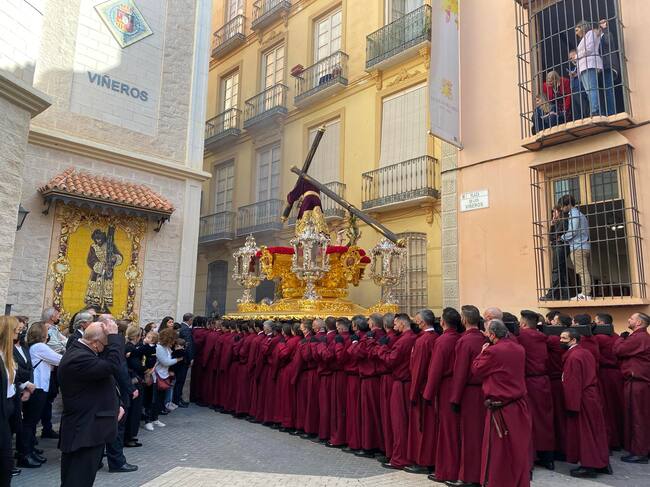Thursday, Málaga´s Holy Week
The holy week is one of the most important events in Spain. Tradition, faith and passion move millions of people from different places around the world. Last year, Malaga welcomed more than 6 millions of visitors because of this celebration.


Malaga city has more than 42 brotherhoods and more than 100 holy images.
Málaga
OUR STAFF
Since the origin of our radio station, SER Malaga funded a professional staff to cover all of the events during this memorable week. Our media is known around Spain working in Malaga for more than 30 years and more than 10000 listeners. He also goes out to the streets to experience the great moments of Lent and, of course, throughout Holy Week.
SANTA CRUZ
Description:
This is the first brotherhood that has its procession on the Maundy Thursday. It has a single float which shows the image of the Virgin at the foot of the cross where she lays the shroud, without the body of Christ. The Virgin, Nuestra Señora de los Dolores en su Amparo y Misericordia, carries in her hands the crown of thorns for Christ. The float is made of varnished mahogany.
How are they dressed?
The nazarenos wear black tail tunics with black capirotes. They wear the shield of the brotherhood embroidered on the chest and a belt made of straw.
CENA
Description:
The float with Jesus is one of the biggest floats within the sections of Christ in the Holy Week of Málaga. It has a large sculptural group where the twelve apostles and Jesus are represented. The float of the Holy Supper represents the moment when Jesus blesses the bread and wine and distributes it to his disciples. Actions such as the washing of feet or the breaking of bread are also represented.
In the section of the Virgin we find the Virgen de la Paz, carved with a sweet face, it is very popular as it appears that the float "dances". In Málaga, this means that along the route it is possible to see the carriers perform a combination of special steps where they follow the rhythm of different marches, making it look as if the float dances. One of the highlights of this procession is its start and end, due to the large dimensions of both floats and the fact that their brotherhood house is on one of the narrowest areas of the city. This is a brotherhood loved by children, who walk with the float during the entire route.
How are they dressed?
The nazarenos in the section of Christ wear red velvet tunics and capirotes with a golden cíngulo as a belt, while the nazarenos in the section of the Virgin wear blue velvet tunics and capirotes with a golden cíngulo as a belt.
VIÑEROS
Description:
This brotherhood has a strong connection with the wine and raisin industry and proof of this is shown in the grapes that are present everywhere in the procession, in both the floats and tunics. In addition, the Viñeros brotherhood house is located just in front of the Málaga wine museum, where you can taste the sweet wines of the province.
One of the highlights of this brotherhood is that the image of Jesus, Nuestro Padre Jesús Nazareno de Viñeros. Each year Jesus carries the key to the Tabernacle of the Church of Santa Catalina, the temple where the carvings are located during the rest of the year.
The float of the Virgin does not carry a canopy, it is the only one with such a characteristic in the city of Málaga. As a curiosity, the carriers of the floats from this brotherhood are known as “correonistas”.
How are they dressed?
The nazarenos in the section of Christ wear wine coloured tunics and capirotes with a golden cíngulo as a belt. The nazarenos in the section of the Virgin wear black velvet tunics and hoods with a golden cingulate as a belt.
MENA
Description:
This is one of the best-known brotherhoods outside of Málaga, because of the link it has with the Spanish Legion. Their union dates back to 1921. Since 1928, the Cristo de la Buena Muerte is considered to be the protector and patron of the Legion. Ever since, this military corps parades with the section of the Christ. It is by far one of the greatest events of the Holy Week and attracts a large number of tourists. In fact, crossing the city of Málaga becomes complicated once this procession starts. The enormous number of people makes it difficult to see the Legion soldiers, but it is easy to listen to them as they sing the popular song “El novio de la muerte” along the entire route.
The arrival of the Legion in Málaga is a big event for the city. During the morning of Maundy Thursday, the Legion soldiers disembark in the port of Málaga to parade through the main roads of the city until they reach the Church of Santo Domingo, the place where the statues of Jesus and the Virgin can be found throughout the year. On this morning, the statue of Christ is moved from his chapel to his float. From Palm Sunday the Legion soldiers guard Christ. This ceremony can be seen until the Holy Wednesday. However, it creates such an attraction in the city that the queues to enter are usually quite long, even though there are other processions on the street.
On the Maundy Thursday morning, the transfer of the Christ to the main float starts once the Legion soldiers arrive at the church. This ceremony is led by the main representative of Spain’s Ministry of Defence, usually the Minister for Defence. The Legion soldiers start singing their song, “El novio de la muerte”, a moment that everyone awaits with great anticipation and the Christ is then transferred to the main float, which is placed inside the church. This is a short ceremony, lasting less than one hour. If you want to stand in a good location it is important to be patient and arrive at the Pasillo de Santo Domingo hours in advance.
Besides all the paraphilia related to the Legion there is one special characteristic of this Christ, the crown of thorns he wears during the procession. There is a new crown of thorns every year and it is only used during the Holy Week. The rest of the year, the Christ is in his chapel with his head uncovered.
The Virgin, La Virgen de la Soledad, is linked to the Spanish Navy. The legend states that in the middle of a great storm a frigate from the Spanish Navy spotted a single point of reference on the horizon. This point seemed to be the light of a building and it guided them to the harbour where they docked and disembarked, in the city of Málaga. The light they followed came from the church-convent of Santo Domingo where the Virgen de la Soledad is worshiped, close to the river. This series of events happened on the Holy Saturday and the sailors asked for a Mass to be celebrated, but this was not possible because it was the Holy Saturday. Such was the fervour of the sailors that they requested that the Bishop granted a special privilege so that every year on the Holy Saturday a mass was celebrated. The Bishop accepted their request and since then the so called, Mass of Privilege on the Holy Saturday, is celebrated. This is the reason why several high ranking members of the Navy parade in this procession, although they are not as numerous as the Legion soldiers.
This is a very particular virgin. First of all, her hands are interlaced and she is carried on an octagonal canopy float, which is unique to the city. The symbol of the Fleur de Lis can be found on the float, in the canopy and in the cape worn by the Virgin. These flowers were used in old maps to indicate North, thereby becoming a nautical symbol that represents the connection the Navy has with the Virgen de la Soledad. Another special characteristic of this Virgin is that, despite her float being so majestic, she is dressed in a very simple way. Almost without jewels and only with some details showing her connection to the Navy. Additionally, she is not wearing any crown, only a halo goes over her head, even though she has been officially crowned by the Church.
How are they dressed?
The nazarenos of both sections, Christ and Virgin, wear black velvet tunics and capirotes with the brotherhood emblem embroidered on the chest.
MISERICORDIA
Description:
This Brotherhood is deeply rooted in its neighbourhood, Perchel. It has many devotees who accompany the floats throughout the processional route. The statue of Jesús de la Misericordia is popularly known as "El Chiquito" (the little one). It represents one of the falls of Jesus in his ascent to the Calvary mount. The image gives the impression of it being small, although if he would be standing Jesus would be 1.80 metres tall.
In the Virgin section of this brotherhood we have Nuestra Señora del Gran Poder. The canopy carried on her float is the oldest one in the Holy Week of Málaga and the only one embroidered with silver thread. On the front side of the canopy we can see the shield of the city of Melilla. The link with this Spanish city, located in the North of Africa, dates back to the first years after the Spanish Civil War when the remains of the aviator Joaquín García-Morato were transferred from Melilla to be buried in the Brotherhood’s chapel, in the church of El Carmen. This is the reason why the Aviation Corp participates in the procession of this brotherhood on the Maundy Thursday.
How are they dressed?
The nazarenos in Christ’s section wear burgundy velvet tunics with black satin capirotes and an embroidered scapular. Those in the Virgin’s section wear black velvet tunics with burgundy satin capirotes and a burgundy scapular. Both sections wear cíngulos as belts.
ZAMARRILLA
Description:
The name of this brotherhood is due to one of the best-known legends in Málaga. To understand the connection between the legend and the name we must focus on the figure of the Virgin. We can see a large red rose on her chest which gives meaning to the legend. This flower represents a bandit called Zamarrilla. The thief, fleeing from the police hid behind the cape of the Virgen de la Amargura. This cape protected him and thanks to the Virgin he could escape. As a gift for the mercy of the Virgin, Zamarrilla gave the Virgin a white rose that he was carrying. Using his own knife he carved a place for it in her chest and, at that very moment, the flower turned a deep red colour. According to the legend, after this happened, the bandit stopped committing crimes and became a monk. This popular story is embroidered on the roof of the canopy carried on the float of the Virgen de la Amargura. Although it is still a tale, there are documents that prove the existence of a bandit in the mountainous area of Ronda (Málaga) known as "Zamarrilla" who was sentenced with the death penalty in 1851.
To perpetuate the legend of the bandit Zamarrilla and the Virgen de la Amargura, Ángeles Rubio Argüelles, who was once a female high ranking member of the brotherhood, had the initiative to place a red rose on the Virgin’s chest perennially. Since the 30s, the Virgin is embellished with this flower, which is replaced with a white rose every Good Friday. This takes us to the second part of the legend. It is said that Zamarrilla, who became a friar, was assaulted and murdered when traveling to Málaga to offer the Virgin a red rose. At that moment his red rose became white, this was seen as a sign of forgiveness. Each year, the flower worn by the Virgin, made of an intense red velvet, is changed for a white one.
How are they dressed?
The nazarenos of the Christ section wear a purple velvet tunic and capirote and a golden cíngulo as a belt. Those in the section of the Virgin wear red velvet tunics, red capirotes and a golden cíngulo as a belt. Both sections carry an embroidered rose on the chest.
ESPERANZA
Description:
Every Maundy Thursday, the blessing of Jesús Nazareno del Paso takes place in the Plaza de la Constitución. The carriers of the float place him facing Calle Larios where he then blesses the entire city. The image of the Jesús Nazareno has an articulated arm which makes the blessing movement possible. This ceremony has been done for more than 400 years. Each year, before the blessing takes place, a famous person recites a sonnet to the Nazareno del Paso. The same blessing ceremony is carried out at another point in the city, the "Tribuna de los Pobres", in Carretería Street. This statue of Jesus is a classic image of breathtaking beauty. Its main feature is the serenity on his face and its large dimensions, it is 1.84 meters in height. On each corner of the float, we can find groups of three children carrying large lanterns above their heads.
The Virgin, Virgen de la Esperanza, receives the great devotion in Málaga, which leads her to be considered as the Virgin of all the Malagueños. It is striking that she only has her hands and face carved, a detail that is not visible in the procession as she is perfectly dressed. One item that stands out is a sash that belonged to the Emeritus King, Juan Carlos I, which she has worn since 1993. This is the biggest and heaviest float of the Holy Week of Málaga. Therefore, the carriers have great physical stature, both in height and weight. This is needed because we are talking about a float that weighs in excess of 4,000 kg. Besides the majesty of such a float, one of the special features of this brotherhood are the leaves we can see on the floor as it walks the streets. Do not be confused and think this is grass, it is not, it is rosemary. This tradition goes back to ancient times and without it the procession of the brotherhood Esperanza would not take place. Minutes before the start of the procession, the acolytes, most of them children, spread rosemary leaves all along the route. Be careful, because everyone wants to take some of the leaves, so there may be real "battles" in order to catch a bit of rosemary. The Virgen de la Esperanza walks along her procession on a mantle of rosemary, which is blessed as she walks on it.
How are they dressed?
The nazarenos in the Christ section wear purple velvet tunics with tail and capirotes of the same fabric, with an embroidered scapular and a golden cíngulo as a belt.
Those in the section of the Virgin wear green velvet tunics with tail and capirotes of the same fabric, with an embroidered scapular and golden cíngulo as a belt.
VERA CRUZ
Description:
This is the oldest statue of the city and it has its procession on the night of every Maundy Thursday. It takes place in complete silence and every year in this procession we can see an important relic, the Lignum Crucis. This is a small piece of the cross where Christ died which has been authenticated by religious authorities. Every Maundy Thursday it is carried by a priest in the procession of the Cristo de la Vera Cruz. Just below the statue of Christ we can see a skull, which represents death.
How are they dressed?
The nazarenos wear black tunics, a green capirote where the Saint John Cross is embroidered and a belt made of straw.






